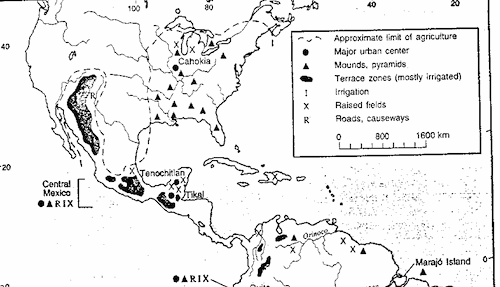William M. Denevan -- "The Pristine Myth: The Landscape of the Americans in 1492"
Lady Jane, July 9 2014
It is somewhat common for people to view the North America of 1492 as a largely untouched wilderness, perhaps in contrast to other areas such as the Aztec and Incan Empires to the south. However, this in many ways is simply the continuation of an initial misunderstanding by the settlers of New England and Virginia. In many areas, American Indians extensively sculpted the local landscape for their own agricultural and infrastructural purposes.
A large part of this misunderstanding arose from the sheer magnitude of the demographic distaster which befell most of the Indian tribes. The population in many areas declined by up to 90% between 1492 and the 1700s. Thus, when white settlement first encroached upon certain areas, "pristine" forest was what they found. In fact, a lot of this forest had simply re-grown itself in the interceding century. There are many estimates to the effect that North America was more densely forested in 1750 than in 1492. All of this due to the biological causes of disease and immunity (the lack thereof).
William M. Denevan, writing about this issue, states that "...most of our eyewitness descriptions of wilderness and empty lands come from a later time, particularly 1750-1850 when interior lands began to be explored and occupied by Europeans. By 1650, Indian populations in the hemisphere had been reduced by about 90 percent, while by 1750 European numbers were not yet substantial and settlement had only begun to expand. As a result, fields had been abandoned. while settlements vanished, forests recovered. and savannas retreated. The landscape did appear to be a sparsely populated wilderness."
Denevan's full essay can be found here. Without the effects he describes, the landscape that revealed itself to white settlement would have been much more open, more cultivated, more populated, and much better defended. It's hard to say what the ultimate result may have been.
Another outstanding book on this topic is Charles Mann's 1491: New Revelations of the Americas Before Columbus.
